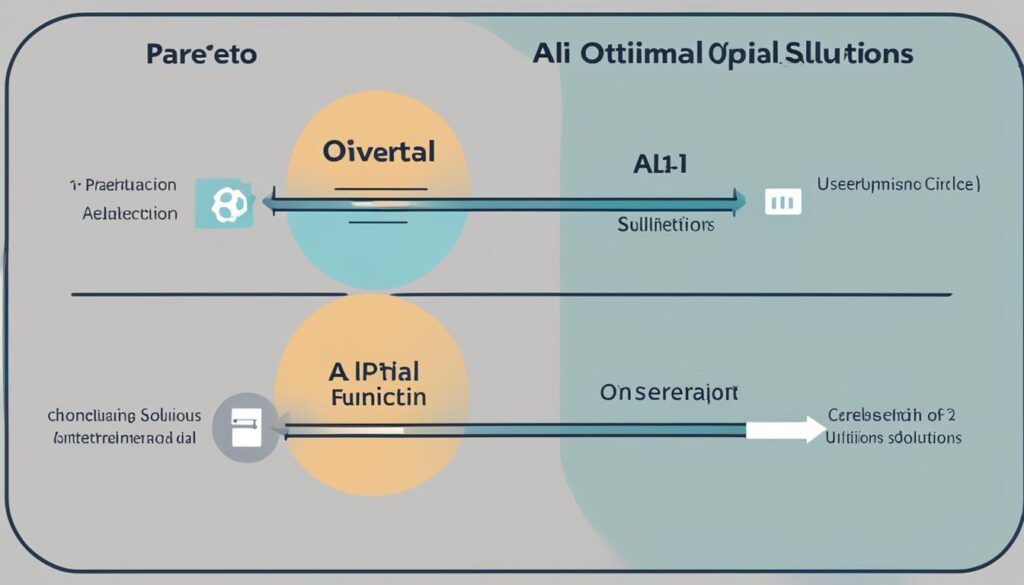Welcome to our article on understanding utility functions in artificial intelligence (AI). As AI technology continues to advance, it becomes increasingly important to understand the mathematical framework that drives decision-making in AI systems. Utility functions play a key role in this framework, allowing AI systems to assign values to outcomes and make optimal choices based on those values.
Utility functions are widely used in various AI applications such as game theory, economics, and robotics. They provide a way to represent the degree of satisfaction or utility associated with different outcomes. By assigning numerical values to outcomes, AI systems can compare and rank these outcomes, enabling them to make decisions that maximize the desired objective.
Whether it’s a game-playing AI determining its next move, an AI-driven investment strategy optimizing returns, or a robot choosing the most efficient path, utility functions are at the heart of intelligent decision-making in AI systems.
Contents
- 1 What is Utility Theory in AI?
- 2 The Role of Utility Functions in AI Decision-Making
- 3 Designing an AI Utility Function
- 4 Balancing Conflicting Objectives in AI Utility Functions
- 5 Pareto-Optimal Solutions and the AI Utility Function
- 6 Conclusion
- 7 FAQ
- 7.1 What is a utility function in AI?
- 7.2 How does utility theory relate to AI?
- 7.3 What is the role of utility functions in AI decision-making?
- 7.4 Why is designing an AI utility function important?
- 7.5 How can conflicting objectives be balanced in AI utility functions?
- 7.6 What are Pareto-optimal solutions in AI utility functions?
- 8 Source Links
Key Takeaways:
- Utility functions in AI provide a mathematical framework for decision-making based on perceived value or utility.
- They assign numerical values to outcomes, representing the degree of satisfaction associated with each outcome.
- Utility functions allow AI systems to compare and rank different options based on their utility values.
- AI systems aim to maximize expected utility by considering the probability of different outcomes occurring.
- Designing an AI utility function involves balancing conflicting objectives and incorporating the economic values of stakeholders.
What is Utility Theory in AI?
In the field of artificial intelligence, utility theory serves as a fundamental mathematical framework for modeling decision-making under uncertain circumstances. Through utility theory, AI systems are capable of assigning subjective values or preferences to different outcomes, thereby enabling them to make optimal choices based on these values. Utility theory finds wide application in AI systems as it allows for the incorporation of preferences and subjective values into the decision-making process. This integration empowers AI systems to select options that maximize specific goals or objectives, enhancing their ability to make informed and advantageous decisions.
Within the context of AI systems, utility theory plays a crucial role in the decision-making process. By utilizing utility functions, AI systems can compare and rank different outcomes or actions according to their assigned utility values. Through this comparison and ranking process, AI systems can identify and select the outcome or action with the highest utility, thereby optimizing their decision-making capabilities. AI systems strive to maximize the expected utility by considering the probabilities associated with different outcomes. As a result, utility functions are pivotal in helping AI systems optimize their decision-making processes, ensuring that the choices made align with their intended objectives.
The Role of Utility Functions in AI Decision-Making
Utility functions play a crucial role in the decision-making process of AI systems. They enable these systems to compare and rank various outcomes or actions based on their utility values, ultimately selecting the option with the highest utility. By aiming to maximize the expected utility, taking into account the probabilities of different outcomes, AI systems can optimize their decision-making processes and make choices that align with their objectives.
In simpler terms, utility functions serve as guides for AI systems, helping them navigate complex decision landscapes. These functions assign numerical values to different outcomes, reflecting their perceived value or degree of satisfaction. By optimizing the utility function, AI systems can make more informed decisions and prioritize actions that are most beneficial to their goals.
“The utility function is like a compass for AI systems, directing them towards actions that maximize desired outcomes and align with objectives.”
To optimize the utility function, AI designers must carefully consider the specific objectives of the system and the preferences of all stakeholders involved. By incorporating the diverse interests and economic values of stakeholders, the utility function can be designed to strike a balance between competing objectives. This process may involve using multi-objective optimization techniques to find solutions that maximize overall utility while accounting for conflicting goals.
The optimization of utility functions plays a critical role in the responsible and ethical development of AI systems. By carefully weighing the various economic values at stake, AI systems can make decisions that align with the best interests of all parties involved, leading to fair and unbiased outcomes.
Benefits of Optimizing Utility Functions
- Ensures decision-making aligns with desired outcomes and objectives
- Allows for the consideration of multiple stakeholders’ interests
- Enables the search for trade-offs and compromises in conflicting objectives
- Promotes fair and unbiased decision-making processes
- Facilitates the identification of optimal solutions that maximize overall utility
The optimization of utility functions in AI decision-making represents a significant advancement in the field of artificial intelligence. By fine-tuning these functions to reflect the values and goals of stakeholders, AI systems can make well-informed choices that serve the common good and lead to positive societal impacts.
Designing an AI Utility Function
When it comes to artificial intelligence (AI) systems, designing an AI utility function is of utmost importance. This process ensures that the actions of the AI system align with the economic value of the stakeholders. To achieve this, it is essential to understand the goals, preferences, and desired outcomes of the stakeholders and incorporate them into the utility function.
During the design process, it is crucial to consider that different stakeholders may have conflicting objectives. Balancing these trade-offs and taking into account the economic values of all stakeholders is key to developing an effective utility function. By carefully crafting the utility function, AI systems can make decisions that maximize overall utility.
Multi-Objective Optimization
In designing an AI utility function, one effective approach is multi-objective optimization. This approach allows for the optimization of multiple utility functions simultaneously, enabling AI systems to find solutions that best meet the diverse objectives of different stakeholders.
With multi-objective optimization, the AI system can analyze the trade-offs between conflicting objectives and identify solutions that strike the right balance. By leveraging this approach, stakeholders with varying economic values can be satisfied, leading to more inclusive and robust decision-making.
Below, we present a table highlighting the benefits and considerations when designing an AI utility function using multi-objective optimization:
| BENEFITS | CONSIDERATIONS |
|---|---|
| Optimizes multiple utility functions simultaneously | Requires understanding of stakeholders’ objectives and preferences |
| Enables trade-off analysis | May introduce complexity to the decision-making process |
| Facilitates inclusive decision-making | Demands careful consideration of conflicting objectives |
Designing an AI utility function that considers the economic values of stakeholders and incorporates multi-objective optimization can significantly enhance decision-making in AI systems. It empowers the AI system to make choices that align with the diverse goals and preferences of different stakeholders, resulting in outcomes that are ethically and economically valuable.

Balancing Conflicting Objectives in AI Utility Functions
Creating a healthy AI model requires balancing conflicting objectives in utility functions. In AI systems, different stakeholders may have varied preferences and goals, resulting in potential conflicts within the utility function. To address this, it is crucial to consider the economic values of all stakeholders and understand their diverse interests.
Constantly seeking to balance the trade-offs between conflicting economic values is essential for optimal decision-making. By incorporating multi-objective optimization approaches, AI systems can achieve a balance that satisfies multiple objectives simultaneously.
Understanding Conflicting Utility Values
Conflicting utility values arise due to differing priorities among stakeholders. For example, in an AI system designed to optimize energy consumption, one stakeholder may prioritize reducing costs, while another may prioritize minimizing environmental impact.
This conflict can be resolved by assigning specific weights or importance factors to different utility values. This allows AI systems to strike a balance that aligns with the overall objectives and priorities of all stakeholders involved.
The utility function should consider the economic values of all stakeholders and balance the trade-offs between conflicting objectives for informed decision-making.
The Role of Economic Value in Balancing Objectives
Economic value plays a vital role in balancing conflicting objectives within utility functions. Understanding the economic values of different stakeholders enables AI systems to make more informed decisions and prioritize actions that maximize overall economic value.
By incorporating economic value into the utility function, AI systems can evaluate the impact of each decision on different stakeholders and make choices that achieve the best trade-off.
| Stakeholder | Economic Value | Priority |
|---|---|---|
| Company X | Cost reduction | High |
| Environmental Agency | Environmental preservation | High |
| Consumers | Energy efficiency | Medium |

Benefits of Multi-Objective Optimization
Multi-objective optimization provides a valuable approach to balancing conflicting utility values. By considering multiple objectives simultaneously, AI systems can find Pareto-optimal solutions that represent the best possible trade-offs among conflicting objectives.
Pareto-optimal solutions enable AI systems to navigate the complexity of conflicting objectives and make well-informed decisions. Each Pareto-optimal solution corresponds to a different balance between the economic values of stakeholders, allowing the AI system to select the most suitable outcome.
In Summary
Balancing conflicting objectives within AI utility functions is crucial for creating responsible and effective AI models. Consideration of the economic values of stakeholders and the use of multi-objective optimization approaches can help achieve this balance, leading to informed decision-making and satisfying multiple objectives simultaneously.
Pareto-Optimal Solutions and the AI Utility Function
Pareto-optimal solutions are the ideal outcomes in a multi-objective optimization problem that strike the perfect balance between conflicting objectives. These solutions cannot be improved in one objective without compromising another. By integrating Pareto-optimal solutions into the AI utility function, you can discover the most favorable compromise between conflicting economic values.
Each Pareto-optimal solution represents a unique trade-off among the various objectives, providing the AI system with valuable insights to make well-informed decisions that align with the preferences and goals of different stakeholders. The utility values of stakeholders play a crucial role in determining the optimal solution.
When an AI system aims to maximize utility while considering multiple objectives and the varying utility values of stakeholders, the Pareto-optimal solutions can guide decision-making. These solutions act as a reference point, highlighting potential trade-offs and enabling the AI system to determine the best course of action.
Integrating Pareto-optimal solutions into the AI utility function ensures fairness and equity by considering the interests and utility values of all stakeholders. This approach prevents favoritism or bias towards one group and allows for a more inclusive decision-making process.
Example:
Imagine an AI system that assists an investment company in decision-making. The company aims to maximize returns for their clients while considering the risk tolerance and financial goals of each individual investor. By incorporating Pareto-optimal solutions into the AI utility function, the system can analyze various investment options and select portfolios that strike the best trade-off between maximizing returns and minimizing risk.
| Investment Option | Return (%) | Risk (%) |
|---|---|---|
| Option A | 8.5 | 12 |
| Option B | 10 | 15 |
| Option C | 7 | 8 |
In the example above, Option B offers the highest return, but it also comes with increased risk. Option C, on the other hand, provides a lower return but with significantly lower risk. An AI system utilizing Pareto-optimal solutions can identify the optimal portfolio that aligns with the utility values of different stakeholders, considering their risk tolerance and financial goals.

By incorporating Pareto-optimal solutions into the AI utility function, you can achieve a more comprehensive and balanced decision-making process. It allows for the consideration of conflicting objectives and utility values of stakeholders, ensuring that the AI system makes choices that optimize overall utility while respecting the preferences and goals of different individuals.
Conclusion
Utility functions are an integral part of decision-making in AI systems, enabling them to make optimal choices based on stakeholders’ desired outcomes and preferences. By assigning numerical values to outcomes, utility functions allow AI systems to compare and rank different options, selecting the one with the highest utility. This mathematical framework plays a crucial role in AI applications such as game theory, economics, and robotics.
Designing an AI utility function requires striking a balance between conflicting objectives and incorporating the economic values of stakeholders. By understanding the goals and preferences of different stakeholders, AI systems can create utility functions that align with their objectives. Multi-objective optimization approaches can be employed to simultaneously optimize multiple utility functions, ensuring more comprehensive and effective decision-making.
Pareto-optimal solutions provide a valuable framework for analyzing trade-offs between competing objectives in AI utility functions. These solutions represent the best compromises between conflicting economic values and enable AI systems to make informed decisions. By considering the diverse interests of stakeholders and finding the best trade-offs, AI systems can deliver responsible and ethical outcomes.
In conclusion, utility functions in AI form the backbone of decision-making processes, allowing for optimal choices based on stakeholders’ preferences. Designing robust utility functions, employing multi-objective optimization techniques, and leveraging Pareto-optimal solutions are pivotal steps towards developing responsible and ethical AI systems.
FAQ
What is a utility function in AI?
A utility function in AI is a mathematical framework that assigns numerical values to outcomes, representing the degree of satisfaction associated with each outcome. It is used to model decision-making based on perceived value or utility.
How does utility theory relate to AI?
Utility theory provides a mathematical framework for decision-making in AI systems. It allows AI systems to assign subjective values or preferences to different outcomes and make optimal choices based on these values.
What is the role of utility functions in AI decision-making?
Utility functions play a crucial role in AI decision-making by allowing the system to compare and rank different options based on their utility values. AI systems aim to maximize the expected utility, considering the probability of different outcomes occurring.
Why is designing an AI utility function important?
Designing an AI utility function is crucial for aligning the AI system’s actions with the economic value of the stakeholders. It involves understanding the goals, preferences, and desired outcomes of the stakeholders and incorporating them into the utility function.
How can conflicting objectives be balanced in AI utility functions?
Balancing conflicting objectives in AI utility functions can be achieved by considering the economic values of all stakeholders, understanding their diverse interests, and constantly seeking to balance the trade-offs between conflicting economic values.
What are Pareto-optimal solutions in AI utility functions?
Pareto-optimal solutions represent the best trade-off between conflicting objectives. They cannot be improved in one objective without worsening another. Incorporating Pareto-optimal solutions into the AI utility function allows for finding the best compromise between conflicting economic values.




